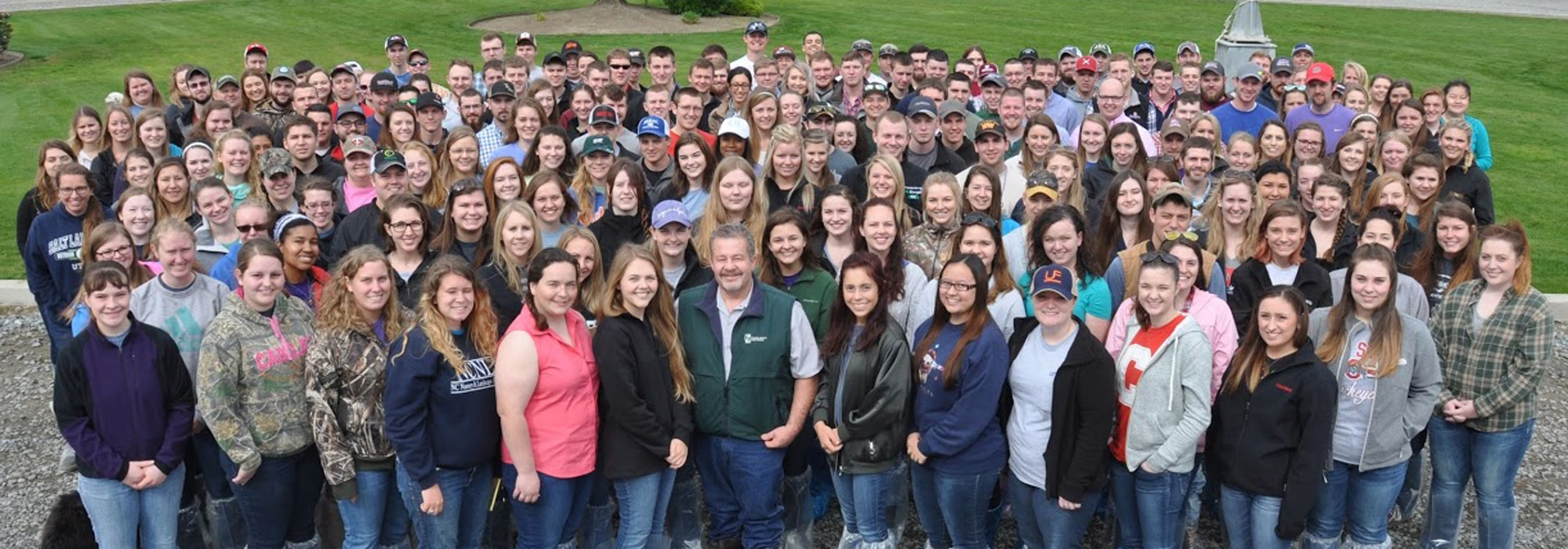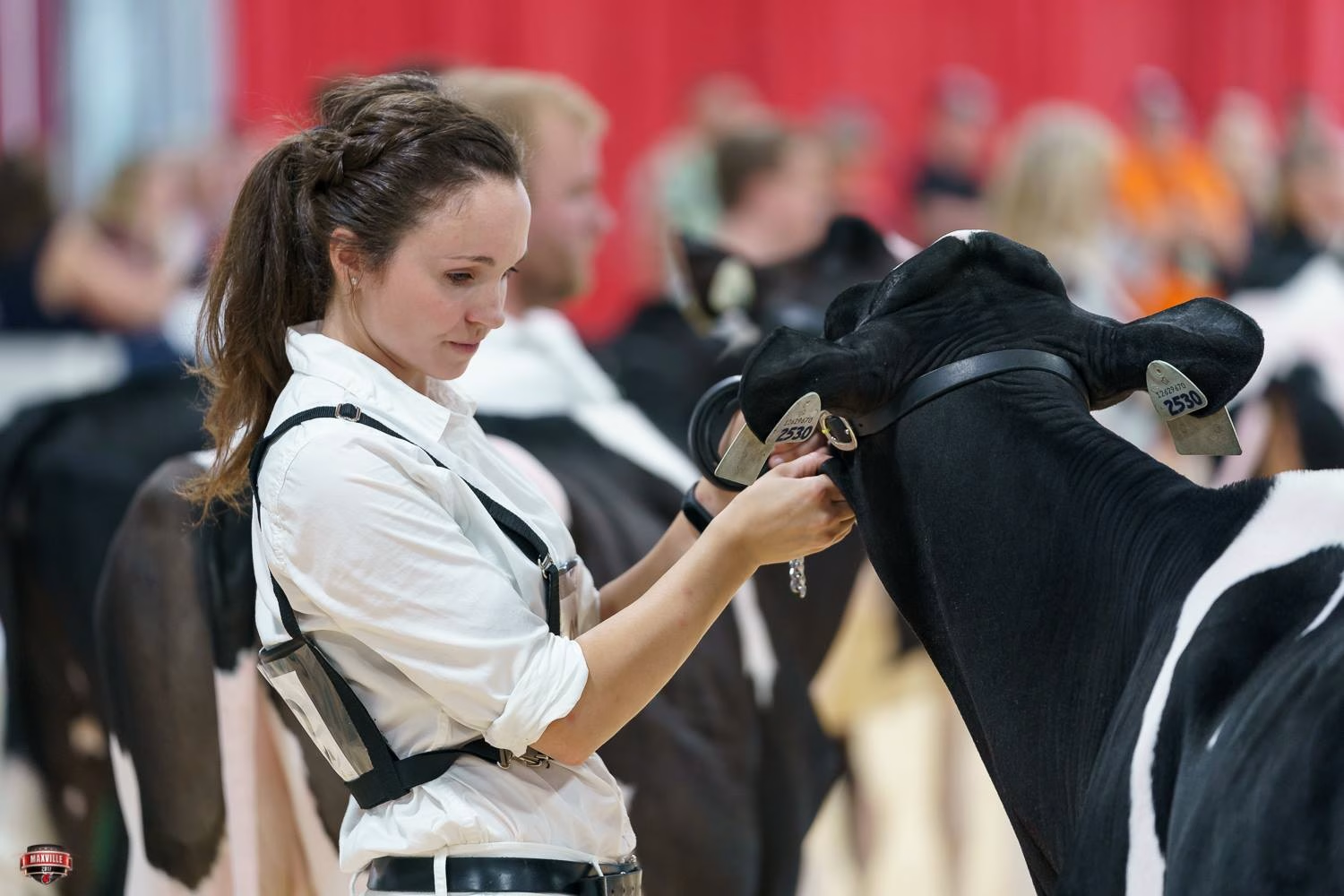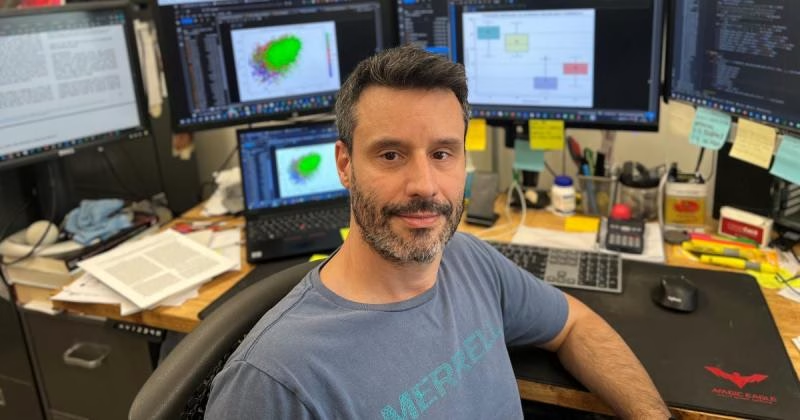Learn how the National Dairy Challenge helps create future dairy leaders. Curious about how students, industry experts, and schools work together to improve dairy skills? Keep reading.

The Dairy Challenge is more than a competition; it epitomizes collaboration among industry, academia, and students, ensuring the program remains at the forefront of dairy management practices. Industry professionals serve as mentors, judges, and sponsors, vital to the program’s success. Participants delve into every facet of dairy farm operations, from feeding and financial strategies to reproductive health and nutrition. This immersive approach equips students with valuable, real-world knowledge. Beyond just a contest, the Dairy Challenge rigorously prepares future leaders in the dairy industry by bridging the gap between academia and industry. The initiative fosters collaboration, knowledge exchange, and innovation, enhancing communication, teamwork, problem-solving, and other soft skills. With over 8,000 alumni, the Dairy Challenge significantly shapes the next generation of dairy sector leaders.
“Dairy Challenge is a case study competition where students from universities across North America apply their skills in feeding, nutrition, reproduction, and finance on real farms.” – David Thorbahn, CEO of Select Sires,
The Origins and Evolution of the National Dairy Challenge: From Academic Roots to Dairy Industry Innovation
The National Dairy Challenge’s inception traces its roots to the Business College at the University of Wisconsin-Madison, where students were organized into teams to conduct in-depth case studies on various businesses. This approach honed their analytical skills and fostered a competitive spirit. David Thorbahn, a key figure in establishing the Dairy Challenge, saw the potential of this model for the dairy industry, envisioning a structure where the complexities of dairy management could be addressed through real-world applications.
Thorbahn’s vision led to a dialogue with Linda Hodorff and others, quickly translating into action. The goal was to bridge academia, industry, and practical experience, nurturing future leaders in dairy management. In 2001, a steering committee of various stakeholders was formed, laying the foundational framework for the National Dairy Challenge.
The first Dairy Challenge occurred in early 2002 at Michigan State University, featuring 14 teams from 12 universities. This inaugural event allowed students to apply their classroom knowledge in natural dairy farm settings, evaluating nutrition, reproduction, and finance areas.
Since then, the Dairy Challenge has significantly evolved, hosting multiple regional and national contests involving around 600 students annually. This growth reflects its success in creating a robust educational platform, facilitating knowledge exchange, and fostering innovation in dairy management. The Dairy Challenge thrives, driven by visionaries who adapted a business education model into a crucial dairy industry initiative.
Mastering Dairy Management: A Comprehensive and Competitive Academic Endeavor
The National Dairy Challenge is a rigorous case study competition that mirrors real-world dairy farm management. It provides a hands-on, competitive platform for university students across North America. The competition begins with forming teams, where students with diverse skills and backgrounds come together to conduct thorough farm evaluations. These evaluations comprehensively review the farm’s operations, including feeding and nutrition, reproduction, veterinary medicine, and finance. Students then develop management strategies based on their findings, applying their skills and knowledge to solve real-time problems in the dairy sector.
Participants analyze dietary regimens, assess breeding programs, evaluate health protocols, and scrutinize farm budgets, ensuring a holistic review of each farm. They work with detailed datasets, including financial summaries and herd performance records, and utilize industry-relevant technologies to analyze data. Direct farm visits deepen their understanding and lead to a synthesis of findings into a cohesive management plan.
The competition culminates with teams presenting their analyses and recommendations to a panel of industry, academia, and farming judges. This final phase tests their technical knowledge, problem-solving abilities, and communication skills, creating a vital link between academic learning and professional application. The Dairy Challenge equips participants with well-rounded expertise, preparing them for future leadership roles in the dairy industry.
Beyond the Classroom: Empowering Students with Real-World Dairy Management Expertise
The National Dairy Challenge offers students unparalleled educational benefits through experiential learning that eclipses traditional classroom settings. By engaging in real-world dairy management scenarios, students acquire a deep understanding of agricultural systems and develop practical skills essential for success in the dairy industry.
A distinctive feature of the Dairy Challenge is its emphasis on practical skills. Students rigorously evaluate diverse aspects of dairy farms—from feeding and nutrition to reproduction and financial management. This hands-on approach imparts theoretical knowledge and ensures students can apply it to solve complex, real-time problems. This comprehensive training leaves students feeling competent and prepared for the challenges of the dairy industry.
Soft skills are equally emphasized in the Dairy Challenge. Students are grouped into teams and must collaborate efficiently to assess dairy operations and formulate comprehensive management recommendations. This high-pressure environment hones their decision-making abilities and fosters critical, swift thinking under tight timelines.
The presentation phase requires students to articulate their findings clearly and confidently, enhancing their public speaking and communication skills. Presenting to industry expert panels, they receive invaluable feedback, further refining their ability to convey information effectively and persuasively.
The National Dairy Challenge bridges academic learning and industry practice, cultivating a well-rounded skill set. This unique blend of practical experience and interpersonal proficiency positions Dairy Challenge participants as highly competent and adaptable professionals prepared to contribute significantly to the dairy industry.
Triad of Excellence: The Collaborative Core Driving the National Dairy Challenge
At the core of the National Dairy Challenge is a dynamic collaboration among students, industry professionals, and academia. This triad forms the foundation of the program’s success, merging theoretical knowledge with practical expertise. Sponsorship from industry stakeholders is crucial, as it provides financial support and ensures access to cutting-edge dairy technology and practices. These resources enrich the learning experience and keep the program relevant to contemporary industry issues. Sponsors also gain visibility and recognition within the dairy sector, enhancing their brand image and market reach.
Equally important is the involvement of industry professionals as volunteers. Serving as judges, mentors, and presenters, these volunteers play varied and impactful roles. Judges offer critical evaluation and feedback, mentors guide students through the complexities of real-world dairy management, and presenters share the latest industry developments and technologies. Their involvement is beneficial and integral to the program, as they help cultivate the next generation of dairy leaders. In return, companies gain unique opportunities to network with potential future employees, ensuring the continuity and advancement of the dairy sector.
A Diverse Geographic Expedition: The National Dairy Challenge’s Comprehensive Contest Structure
The National Dairy Challenge features a robust schedule of regional and national contests designed to cater to a wide geographic diversity and ensure comprehensive participation from universities across North America.
Each year, four regional contests are hosted:
- Northeast Region: Typically held in the fall, bringing together students from universities in the northeastern United States.
- Southern Region: This event will also be held in the fall and cater to universities and students from the southern United States.
- Western Region: This region is held early in the year, often around late winter to early spring. The upcoming Western contest is slated to take place in Richmond, Utah.
- Midwest Region: The event is set for early February, with locations rotating among the Midwestern states. This year’s event will be in Green Bay, Wisconsin, following a previous hosting in Iowa.
The national contest rotates annually among the regions, providing a fresh and varied experience each year. Here are the upcoming locations for the national contests:
- 2024: California, offering a diverse dairy landscape on the West Coast.
- 2025: Florida, presenting students with insights into dairy operations in the southeastern United States.
- 2026: South Dakota, bringing the event to the heart of the American Midwest.
- 2027: Michigan State University, a nod to the roots of the Dairy Challenge and celebrating its 25th anniversary.
This rotation ensures that students gain exposure to various dairy management practices and regional dairy challenges, enriching their learning experience and preparing them for diverse careers in the dairy industry.
Firsthand Testimonials: Alumni and Industry Leaders Highlight the Dairy Challenge’s Transformative Impact
“When I just got out of college, the most valuable experience I had was the Dairy Challenge,” gushed a recent graduate who returned to manage his family’s 5,000-cow dairy in the southwestern United States. The practical knowledge and hands-on experience gained through the Dairy Challenge prepared him for the complexities of modern dairy management, facilitating a smooth transition from academia to real-world application.
Although not a Dairy Challenge participant, Erin experienced its benefits secondhand. “I’m married to a Dairy Challenge participant, and I’ve seen firsthand the skills that students gain. The teamwork, decision-making, and presentation skills developed are invaluable.” Her company’s involvement in the Dairy Challenge further solidified its importance as they recruited alumni who exemplified these skills, significantly contributing to their operational success.
From an industry perspective, Dave shared a memorable encounter: “One example was at a 5,000-cow dairy where I asked the son, fresh out of college, about his most valuable college experience. His immediate response was, ‘Dairy Challenge.’ Comments like these make it clear how essential this program is.” This unique form of validation underscores the transformative impact of the Dairy Challenge on participants and the industry’s perception of its value.
Industry sponsors also echo the profound positive outcomes. Mike Westfall from Farm Credit mentioned, “Sponsoring Dairy Challenge isn’t just about funding; it’s about investing in future leaders. We see firsthand the exceptional talent and passion these students bring.” His remarks highlight the dual benefits of sponsorship—supporting education while securing a pipeline of skilled professionals.
Numerous participants’ personal growth and career advancements testify to the Dairy Challenge’s unparalleled contribution to the dairy industry. Its influence extends beyond national borders, shaping the future of dairy management with each cohort of newly minted industry leaders.
Global Ripples of Excellence: The Dairy Challenge’s Influence Beyond North America
The National Dairy Challenge’s approach to hands-on dairy management has revolutionized education in North America and has influenced similar programs globally. A noteworthy example is in China, where a former Dairy Challenge assistant coach initiated a parallel program. Now, 65 Chinese universities participate, embracing the same high standards and collaborative principles. This success highlights the universal appeal and adaptability of the Dairy Challenge model.
China’s embrace of the Dairy Challenge underscores how academic rigor and industry collaboration can enhance practical skills, setting a precedent for other countries. As interest in replicating this framework grows, international partnerships and knowledge-sharing opportunities expand. Such collaborations promise to elevate dairy education globally and foster a more interconnected industry.
The National Dairy Challenge has become a global model for experiential dairy education. Its international success showcases its adaptability and the widespread desire for such paradigms, paving the way for future collaborations and potential global educational revolutions in dairy management.
The Evolving Landscape of the National Dairy Challenge: Innovations and Expansions Fueling Future Growth
The trajectory of the National Dairy Challenge promises continuous growth and innovation. The Academy for Younger Students has brought fresh perspectives, helping early-stage talent transition smoothly into the dairy industry. This initiative diversifies participants and enhances the competition’s educational impact.
The Dairy Challenge Vet Competition exemplifies significant expansion, engaging veterinary students and integrating animal health more closely with dairy productivity. This interdisciplinary approach aligns with industry needs, where comprehensive knowledge is crucial.
Looking forward, opportunities for further innovation abound. Enhancing data analytics skills through advanced software can better reflect technological advancements in dairy management. Incorporating themes like sustainability practices and low-carbon technologies will make the challenge more relevant and cultivate future-ready dairy professionals.
International expansion remains a promising avenue, with initial steps taken in markets like China. As global dairy practices evolve, the Dairy Challenge has the potential to collaborate with international institutions, share best practices, and foster a global community of dairy experts. Continuing this spirit of innovation, the Dairy Challenge is set to lead experiential agricultural education for years to come.
Unlocking Opportunities: How to Engage with the National Dairy Challenge Across Different Roles
Engagement in the National Dairy Challenge offers many opportunities for students, professionals, and industry leaders. Whether you’re a student looking to showcase your dairy management skills, a professional seeking to mentor and recruit top talent, or an industry leader aiming to stay at the forefront of technological advancements, here’s how you can get involved:
- For Students: Contact your university’s agriculture or dairy science department to express your interest in participating. Preparation typically involves taking related courses and engaging in farm management activities. Many universities have dedicated coaches who can provide guidance and facilitate your involvement.
- For Industry Professionals: Volunteer as a mentor or judge during regional or national contests. This hands-on involvement helps shape the dairy industry’s future and allows you to identify and recruit top talent directly.
- For Industry Leaders and Sponsors: Consider sponsoring the National Dairy Challenge at various levels. Sponsorship can provide significant exposure, networking opportunities, and direct access to student resumes and job fairs. Sponsors often participate in educational presentations, mixers, and other networking events, fostering deeper ties with future industry leaders.
- For Educators: Facilitate the formation of teams from your institution and integrate Dairy Challenge preparation into your curriculum. Encourage interdisciplinary collaboration among dairy science, business, veterinary studies, and agricultural engineering students to help them excel in the competition.
To volunteer or sponsor, contact the Dairy Challenge organizers through their website at dairychallenge.org. For alumni looking to stay engaged, taking the alumni survey via the website can connect you with volunteer opportunities tailored to your interests and expertise. Your involvement benefits the participants and contributes to the sustainability and innovation of the dairy industry.
The Bottom Line
The National Dairy Challenge exemplifies excellence by uniting students, industry professionals, and academics to mold future dairy leaders. This initiative turns academic knowledge into practical expertise through competitive case studies and real-world farm assessments. Regional and national levels provide unique immersive learning opportunities, focusing on soft skills, hands-on experience, and industry-standard technologies, ensuring participants become future leaders. Key elements include the program’s history, the diverse skills it fosters, and its collaborative solid network. Testimonials from alumni and industry veterans highlight its lasting impact, while international expansion shows its broad influence.
Support from the dairy community—as sponsors, volunteers, or advocates—is essential for its continued success. By contributing your expertise, resources, or time, you invest in the future of dairy agriculture. Let’s champion this initiative to ensure it thrives and inspires the next generation of dairy leaders.
Key Takeaways:
- The National Dairy Challenge is a case study competition bringing together students from universities across North America to apply skills in feeding, nutrition, reproduction, and finance on real farms.
- It fosters collaboration among students, industry professionals, and academia to enhance dairy production skills and develop future leaders in the dairy industry.
- Founded in 2002 at Michigan State University, the program has expanded to include over 600 students annually through regional contests, national contests, and specialized academies.
- Participants gain comprehensive hands-on experience, analyzing real farms and presenting detailed recommendations, which helps improve their technical and soft skills.
- The initiative receives significant support from industry sponsors, providing financial backing and volunteer expertise, which in turn helps sponsors recruit top talent.
- Success stories from alumni and industry leaders highlight the transformative impact of the Dairy Challenge on career trajectories and industry standards.
- The program’s influence extends globally, with similar initiatives being established in countries like China, demonstrating its international appeal and effectiveness.
- Ongoing innovations and expansions, including the introduction of robotic milking systems and sustainability practices, keep the Dairy Challenge at the forefront of dairy industry education.
Summary:
The Dairy Challenge is a program that connects academia and industry by involving students from universities across North America in real-world dairy farm management. Originating from the Business College at the University of Wisconsin-Madison, the program has evolved significantly since its inception in 2002. It hosts multiple regional and national contests, involving around 600 students annually. Students form teams and conduct thorough farm evaluations, developing comprehensive management strategies in areas such as feeding, nutrition, reproduction, veterinary medicine, and finance. They analyze dietary regimens, assess breeding programs, health protocols, and scrutinize farm budgets. The competition culminates with teams presenting their analyses and recommendations to a panel of industry, academia, and farming judges, testing their technical knowledge, problem-solving abilities, and communication skills. The Dairy Challenge offers students unparalleled educational benefits through experiential learning, allowing them to develop practical skills essential for success in the dairy industry. Industry sponsorship provides financial support and access to cutting-edge dairy technology and practices, enriching the learning experience. The National Dairy Challenge promises continuous growth and innovation, with initiatives like the Academy for Younger Students and the Dairy Challenge Vet Competition exemplifying significant expansion.













